ASUS ZenBook 17 Fold OLED review: a promising Windows hybrid foldable
ASUS is one of those companies that doesn’t shy away from experimenting with form factors and design. The ROG Flow X13 became the first 2-in-1 ultrabook aimed at gamers followed by the Flow Z13, a powerful Windows gaming tablet mimicking the Microsoft Surface Pro. Now we have the ZenBook 17 Fold OLED, a large Windows tablet with a screen that can fold right in the middle. It also comes with a super slim Bluetooth keyboard, allowing you to use it in laptop mode or prop it up like a desktop. Sounds enticing, doesn’t it?
However, the ZenBook 17 Fold OLED is not a mass-market product, but rather just a proof of concept. This raises the question, does it make sense to spend a lot of money on a first-generation product? Let’s find out.
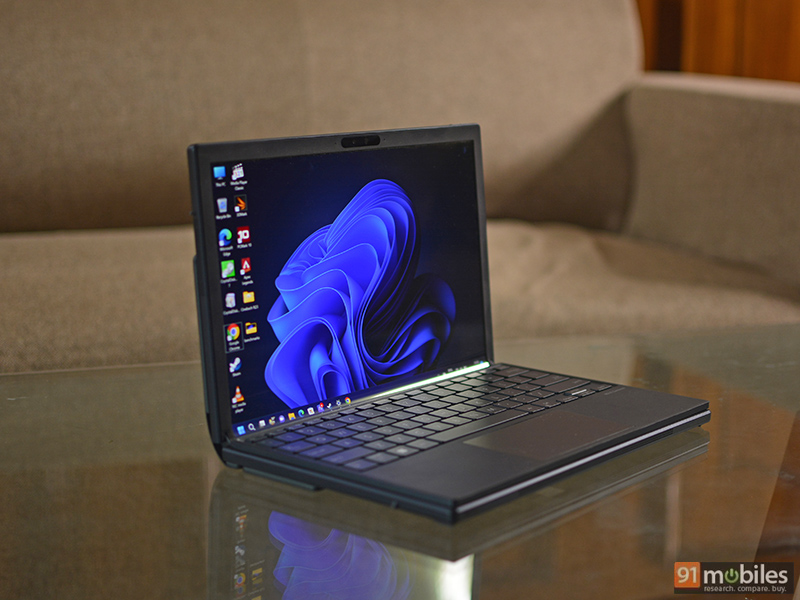
Design and build
In my first impressions, I mentioned how the design has been inspired by Lenovo’s ThinkPad X1 Fold. Yes, the ZenBook 17 Fold OLED isn’t the first foldable hybrid laptop. Lenovo has launched not one, but two iterations of the X1 Fold. Physically the ZenBook 17 Fold OLED works as it should. I had no issues with the hinge mechanism while folding it, the discrete kickstand offers enough support for the tablet to stand upright, and even the keyboard slaps on fairly well using magnets. Thanks to its folding form factor, you have multiple ways of using this machine. Apart from laptop mode, you can use it in desktop mode, tablet mode, reader mode and extended mode. It even comes with a folio case, that allows you to carry it around safely.

ASUS has also used premium materials like magnesium-aluminium alloy, faux leather and frosted glass that add premium aesthetic value. The device is also certified for military-grade MIL-STD 810H durability, thus it can resist shocks, extreme temperatures, vibration, moisture and more. While I believe it can definitely take a few knocks, I don’t think it can survive in extreme environments. Additionally, the hinge has been tested for durability and is said to last for at least 30,000 cycles.

Folding it shut makes it quite chunky, and while I appreciate the synthetic leather for a folio-like finish, it just felt out of place when compared to an ultraportable notebook. It has a total weight of 1.8kgs (300 grams for the keyboard) and a thickness of 1.25-inches in clamshell mode. The thickness does take a while to get used to, especially in laptop mode. But it is really hard to ignore that you always have a large 17.3-inch display at your disposal. This definitely makes it highly compact when compared to traditional 17-inch laptops.

Now it is essentially just a tablet, so the I/O is very limited. You get two USB-C based Thunderbolt 4 ports that support display out and power delivery, and a 3.5mm combo audio jack. ASUS does bundle a USB Type-C to Type-A adapter in the box, so that can come in handy. You will find also find a power button, the volume rocker, air vents at the top and some perforated sections for the quad-speaker system, which delivers surprisingly great audio. It’s not as good as the iPad Pro, but comes very close.

As per ASUS, the ZenBook 17 Fold OLED is not user serviceable, so you cannot get access to the internals. Notably the only replaceable/upgradable component is the M.2-based NVMe SSD.
Display
The screen is the showstopper and on paper, it sounds quite good. Having a resolution of 2,560 x 1,920 pixels (when fully open) the panel promises to reach up to 500 nits brightness for HDR content, and about 350 nits for general use. It also supports Dolby Vision, covers 100 percent of the DCI-P3 colour gamut, has Display HDR True Black 500 certification, PANTONE validation and a blue light filter for eye protection.
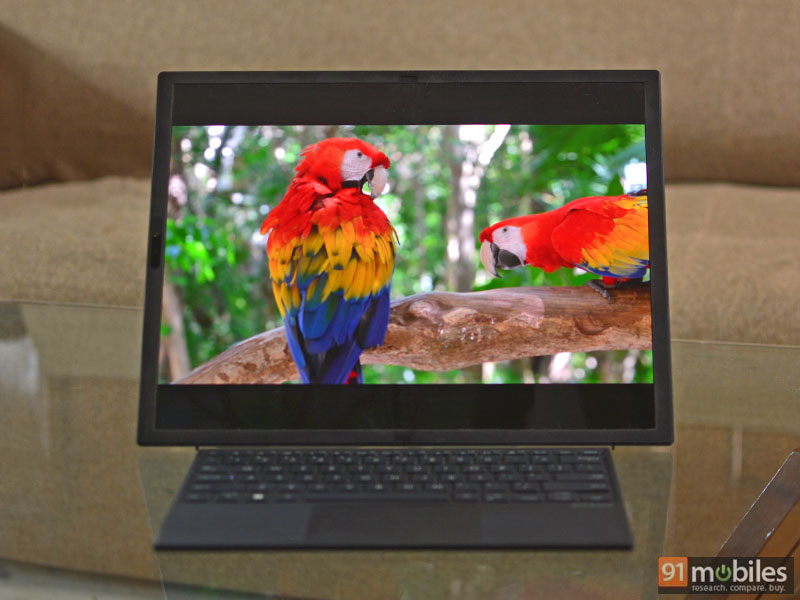
The flexible OLED or F-OLED is manufactured by BOE and features a thin glossy plastic layer on top for protection. Annoyingly, it easily picks up fingerprints, smudges and dust while also being quite reflective. This also means that you cannot use a stylus although it is touch-enabled and is fairly responsive too. The bezels are noticeably thick but one can’t really criticise them much as they are necessary to protect the flexible nature of the OLED panel. Since it is a large 17-inch tablet, the bezels also ensure you get a good grip and additionally work as a platform for the Bluetooth keyboard when using the device in laptop mode. The top bezel also houses the 5-megapixel webcam that supports 1080p video and infrared for Windows Hello face recognition.
Brightness levels are good for general indoor use, but I wasn’t really impressed when using it outdoors. Overall colours on the OLED panel look really good and even the contrast seems pleasing especially when watching Dolby Vision content. There are also a ton of display optimisation settings available in the MyASUS app and I highly recommend tinkering with them. Apart from changing the colour profile, you can enable or disable the eye protection filter, change the white balance, and much more. ASUS has also taken measures to protect the OLED display from burn-in issues to increase the lifespan of the panel. As for the crease in the middle, it is prominent but I did not find it distracting when the display is lit up.
Keyboard and trackpad
The ZenBook 17 Fold OLED comes with the unique ASUS ErgoSense Bluetooth keyboard. It is one of the slimmest Bluetooth keyboards that I have seen with a thickness of just 5.5mm. It comes with a built-in trackpad, a power switch and a USB-C port for charging. The key travel is decent, much like any laptop keyboard, and the battery is said to last for about a week. The keyboard can also connect with up to devices, thus you can pair it with an additional device like your desktop or an iPad. There are a couple of built-in magnets that allow the keyboard to stick onto the lower part of the tablet to transform into a regular clam-shell style laptop.

All of this sounds impressive, but there are certain issues that need to be addressed. First of all, the keys are not backlit, which is understandable considering how slim the keyboard is. Basically, when using this machine at night, you have to rely on the brightness of the display. The magnets that help keep the keyboard in place on the bezels are not strong enough which makes the keyboard wobble when using it in laptop mode.
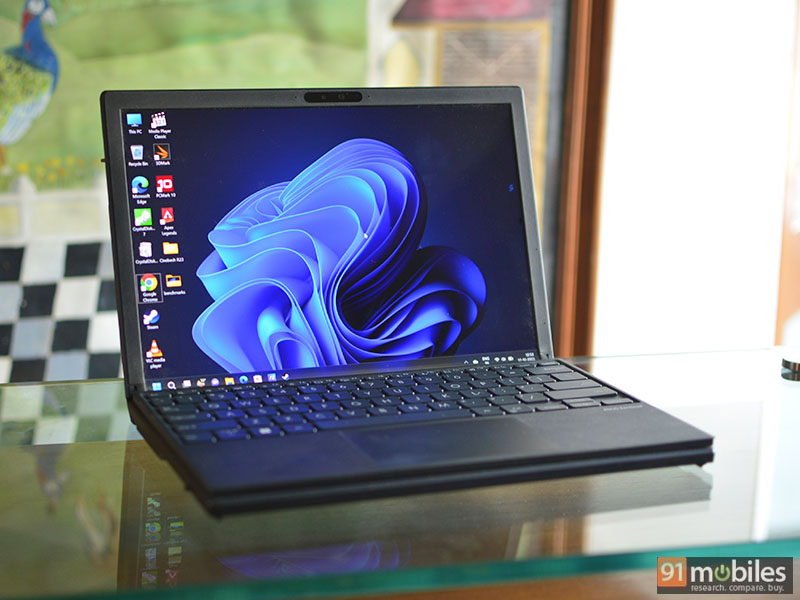
This issue goes deeper as the small gap between the keyboard and the display (which is a necessity) leads to a mushy typing experience. Lastly, the trackpad is flawed. It doesn’t register the left and right clicks properly and the pointer tends to jump around occasionally. There are also latency issues, especially when you wake up the tablet from sleep. I do have to mention though, all of these issues feel less annoying when using the keyboard on a flat desk or table.
To sum it up, it’s a great innovation but poorly implemented.
Performance and software
Let’s talk about the core hardware. The tablet comes with Intel’s 12th-gen Core i7-1250U processor that features two performance cores, eight efficient cores and the Iris Xe integrated GPU. There is 16GB of DDR5 RAM running at 5200MHz and a 1TB of M.2 PCIe Gen 4 NVMe SSD. For wireless connectivity, there is Wi-Fi 6E, and Bluetooth 5.0. This is the sole configuration that ASUS is offering in India.
The hardware offers good performance that is suitable for daily productivity and media consumption. Unlike the more powerful H-series processors, the Core i7-1250U is a lightweight chip with a rated base TDP of 9W that can boost up to 29W. This was pretty much on spot when I stress-tested the machine with some benchmarks. As for the thermals, the CPU is cooled using a cold plate with dual copper pipes connected to a single cooling fan. The core temperatures of the CPU peaked at 96°C in my testing, however, the average temperatures hovered around 42-45°C. Apart from day-to-day workloads, the CPU is capable of handling light video and photo editing as well. There is no dedicated GPU, so gaming is a big no. I was hardly getting 30FPS in Apex Legends when it barely managed to run, after two failed instances. It is also worth noting that certain applications would only run on the entire screen and glitch out if you use them in laptop mode with only half the screen. Some of the apps did resize on their own while others required me to remove and then reattach the Bluetooth keyboard.
Running Windows 11 out of the box, there aren’t a lot of pre-installed apps apart from MyASUS. This is the core control centre where you can access various settings including power, performance, audio, display, connectivity, input devices, privacy and security. There is also a special tool called ScreenXpert that quickly allows you to stack up to three windows either in landscape or portrait mode. It also offers additional controls like the ability to switch your camera and microphone on or off, switching between apps when using multiple displays and more.
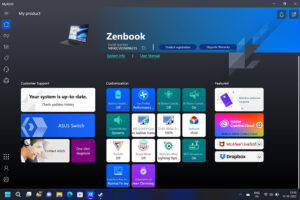
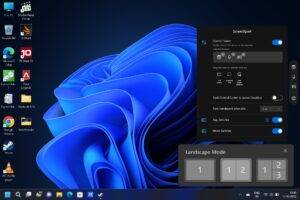
Battery life
The battery on the ZenBook 17 Fold OLED is rated at 75WHrs and can be charged using the 65W charging brick via USB-C. The large size of the screen does lead to quite a bit of power consumption, though I found the battery life to be above average. Using the efficient power mode and brightness pulled down to about 60 percent, I got six and a half hours of usage when using the full 17.3-inch display. Running a video on loop in SDR resulted in about four hours of battery life. Using only the top half (12.5-inch) in laptop mode, you can get close to 10 hours.
Verdict
In terms of concept, the ZenBook 17 Fold OLED gets all my praise. One can enjoy content on its large 17.3-inch OLED display and when you don’t have the space, simply slap on the keyboard to convert it into a portable laptop. You can even use it as a tiny desktop or utilise the entire length of the display in extended mode. The OLED screen is gorgeous (if not class-leading), it has enough horsepower for everyday tasks, and it even looks and feels premium to some extent.
However, it is only when you use the device for a few days that you realise some of the inconsistencies. The glossy finish on the display feels like a sore thumb, the Bluetooth keyboard needs a complete rework and switching between modes doesn’t feel very fluid. Then there’s the price. At Rs 3,30,000, this first-generation hybrid Windows machine can only do so much when it comes to core performance. In my opinion, it might not be worth spending so much.
There is no doubt that ASUS has put in an honest effort, but at the end of the day, the ZenBook 17 Fold OLED remains a proof of concept that can potentially become a mass-market product in the coming years.
Editor’s rating: 3.5 / 5
Pros:
- Large 17.3-inch screen
- Fairly bright f-OLED panel
- Premium materials
- Great speakers
Cons:
- Keyboard needs improvement
- Extremely expensive
- Average performance
The post ASUS ZenBook 17 Fold OLED review: a promising Windows hybrid foldable first appeared on 91mobiles.com.
from 91mobiles.com https://ift.tt/Icy0Yfd
>



No comments